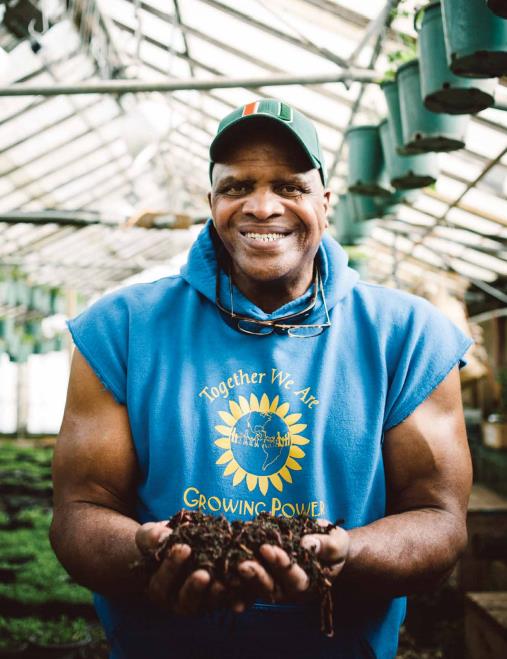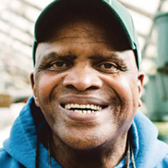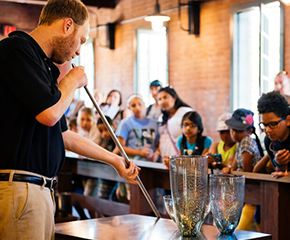
Curiosity & Agricultural Innovations
Will Allen
The celebrated guru of urban agribusiness says grow food and watch communities thrive.
His father was a sharecropper. His mother came from a family that had been farming more than 400 years. He grew up farming in rural Maryland, where he had to plow, plant and harvest before he could go play. But a young Will Allen didn’t have his head wrapped around farming. He was passionate about hitting home runs and shooting hoops. And he was good at it. He eventually fled the farm and became the first African-American to play basketball at the University of Miami. He even went pro after college with the American Basketball Association.
But something happened one day when a teammate asked Allen to come help dig up potatoes on a family farm. “I felt something that was a transformative moment for me,” remembered Allen. “I had missed it [farming].”
Today, Allen is the quintessential icon of the urban farming movement—a master farmer with more than 50 years of growing under his belt. His innovative techniques in seeding, vermicomposting and aquaponics have built the multimillion-dollar operation Growing Power from a two-acre farm in Milwaukee. Here, Allen still personally nurtures more than 20,000 plants and veggies, creates compost from more than 180,000 pounds of waste per week, raises thousands of fish of varying types and tends to an ever-expanding flock of chickens, goats, rabbits and more.
Along with selling what he harvests to neighboring communities in need, he is equally committed to sharing what he knows. He is training urban youth in his farming techniques so they, too, can grow their own good food, wipe out inner-city food deserts and start building healthy, sustainable food systems for future generations. Already, these well-trained prodigies are running more than a dozen additional Growing Power farms in Illinois and Wisconsin as well as a dozen more regional training centers across the U.S.
When The Henry Ford interviewed Allen as part of the OnInnovation initiative, Allen admitted that he really didn’t have a plan early on, but he did have a vision and an intense curiosity. More important, he was always willing to get his hands dirty and experiment with new ideas and different approaches to tried-and-true techniques.
OI: Urban agriculture. What is it?
WA: Urban agriculture is a different kind of farming. You start looking at farming in a different way. You look at it in terms of square footage instead of acres. And you look at it in terms of the idea that you need to grow good food year-round.
If you look around the country, there’s a period of about six months when you don’t have that good food. Where industrial agriculture controls the system, because they’re the only show in town. In my lifetime, we’ve lost more than 2 million farmers in America. We’ve gone from 200-acre farms to 20,000+-acre farms.
We’re dependent on about five states for our fresh fruits and vegetables, or we go outside the country. In some cases, by the time the food gets into our bellies, it could be 14 days old. It is picked. It sits in the field, is processed, goes to a warehouse, is loaded onto a refrigerated truck and heads down the road for three or four days, sits at a wholesaler, is delivered to a grocery store, is set on a shelf where you buy it, take it home and put it into your refrigerator until you eat it. Up to 14 days!

Urban agriculture can create a situation where people have another choice. Where they can buy locally produced food all year long. Where it goes from growing in the ground or on the vine to potentially getting in your belly with all its nutrients intact within a day and a half.
OI: How do you create that situation?
WA: To really go into action, really make it commercial and scale things up, you need to grow soil, because soil is at the very basis of all farming.
Inside our cities, the soil is highly contaminated. So, composting is the thing we do, growing soil is what we have to do. And there are plenty of materials, in terms of the waste that we create, the waste that we haul out into the countryside and put in a big hole. Organic and vegetable waste. Horse manure. Some cities even put leaves in their landfills. If we can rescue all of this material, compost it and turn it and grow new soil, then we have a chance of really scaling this thing up.
Imagine all the different types of local jobs we could create with this new type of agriculture. The communities we could grow. It could be similar to the industrial system, but local with planners and finance people to folks installing renewable energy systems to operate greenhouses. There would be truckers involved, composters involved, salespeople involved to sell the produce to stores and do outreach and marketing. Imagine the environmental impact if we had 10 percent less trucks driving produce across the country from California.
OI: You seem very passionate about farming and your vision for its future. You are from a family of farmers, correct?
WA: My father was originally a sharecropper from South Carolina, and even though he had a construction job while I was growing up, he always wanted me and my brothers to know where our food came from. So, we had a small farm. At the time, I looked at the farm as just hard work while our friends were out there having a good time. But it was really a gift because we always had food. Probably 85-90 percent of the food we ate, we produced ourselves. Having food is a very powerful thing to have.
And we were able to share that food with our extended family and friends. My mother used to fix enough food for probably 30 people every day. That’s how friendships were built, why my parents always had a way to get places even though we didn’t have a car and why there was always help when things needed to get done. My parents really understood that food is at the very basis of our survival and at the basis of our communities’ survival. Without a strong food system, a community cannot call itself sustainable.
OI: Your career path? How did you go from the farm to professional basketball back to the farm again?
WA: When I was a teenager, I fell in love with basketball. I used to sleep with a basketball. After just two years of playing the game, I became a high school All-American. I had more than 100 scholarship offers and decided on the University of Miami.
I rejoiced and said, “Never again will I do this farming stuff. I’m going to college, getting an education and playing professional basketball.”
When I started playing basketball in Belgium after playing with the American Basketball Association, a teammate asked me to come help out his family on their farm. It was a transformative moment for me. I eventually took a place in the country in Europe, started growing food and got 25 chickens.
When I returned to the States, I had this burning desire to farm. One day I was driving to see a client while working a corporate job for Procter & Gamble, and I noticed this for-sale sign on an old greenhouse farm in Milwaukee.
Long story short, I cashed in my retirement, got a loan and took the big gamble—the risk—and started an urban farm.
OI: So is that how Growing Power got started?
WA: At first, I was running as a for-profit, taking my produce and selling it. About two years in, I sat on a board for a hunger-fighting organization. The director called and asked if I would help a youth group that wanted to grow an organic garden. That’s why I’m sitting here today. Those kids led to more groups, a nonprofit business and a continuum that allowed me to try this and that.
OI: What types of “this” and “that” have you tried?
WA: I like to call it my country research, my trial-and-error research. We started vermicomposting. And I really got hooked on the worms. I wanted to know their favorite food. What is the best temperature that they like to be in? What triggers reproduction?
They are really livestock. They eat all the compost and food and turn it into wonderful fertilizer. I have just kept increasing the volumes, building these huge worm depositories.
Give me a handful of worms today, drop me off anywhere in the world, and I can build you a system as big as you want.
Then it was aquaponics. I started digging trenches inside the greenhouse and raising tilapia first, learning how the fish give off waste and the plants take the nitrogen out. It’s a symbiotic relationship. Now, we raise thousands of lake perch, too, which require high water quality to survive.
I call it a food system puzzle. And you’re always adding a piece to the puzzle to make some of the things work better. You’re always thinking on how to improve what you’re doing. With aquaponics, how do I capture water? How can I use the earth to heat the water?
With every system I thought about and started creating, I wanted it to be something that people could do without spending a lot of money or going really high-tech.
OI: Simple ways to raise good food?
WA: Yes. Our fish run system, for example, costs about $3,000. That same system would cost $50,000 if you had all the bells and whistles of bead filters. Our system uses the same water being cleansed by the plants. And then you’re able to harvest and sell those plants. It’s a very attractive kind of system for communities not only here in the U.S. but around the world.
I think that’s what really makes me happy. None of this stuff is necessarily new technology—ancient civilizations used aquaponics, for example. But watching people from other countries such as Africa come in and take one of our tours or workshops and then take these systems back to their countries, their farms, their cities or their organizations and start building them—maybe building them a little different than ours, but adapting them using our techniques.
OI: Was that part of your grander plan to “grow” Growing Power? To create affordable techniques which are also highly adaptable, scalable?
WA: I really didn’t have a plan. It was more of an evolutionary thing, a natural, spiritual kind of revolutionary process. When I work, I do this kind of visioning. I don’t put things on paper. It’s just in my head. I look at the present, maybe five years from now, 10 years and then try to make it happen.
I tried to come up with all these little profit centers. They could be individual businesses like the aquaponics. Growing fish could be a business. Growing sprouts could be a business. We had bees. Selling honey could be a business. Composting could be a business. So within this structure, we started to develop all these individual little businesses with income streams that were all housed within a nonprofit.
Today, Growing Power has 60 employees, 15 farms and 30 or more income streams that have been very profitable, allowing us to fund the other side of the business, our social responsibility and training programs.
OI: Can you talk more about the training programs, the workshops?
WA: When people come, they learn the basics. They still have to go back and practice the art, because farming is an art just like anything else. We teach them how to grow sprouts. That they are easy to seed in flats. That you cover one flat with another flat and in three days those seeds in the bottom flat come up and start pushing the top flat up. And you remove it, put it in the sun. Four days later, you’re harvesting.
When they come to a workshop, they learn how to build an infrastructure for an aquaponic system. We teach them how to do compost using layers of carbon and nitrogen in a 4x4 configuration that they can replicate at home easily. We teach them how to build a worm bin and maintain the bin so that they can get 700 pounds of finished worm castings at $4 per pound. For a product that started out as waste, that’s pretty good money.
OI: What does your typical day look like today?
WA: Training is an ongoing piece, and there are some things on the farm that I do—that only the principal farmer does. Like seeding. We have 25,000 pots hanging because we do vertical farming. Sometimes in one little pot there are 500 seeds. And it’s all done by hand. So in a given day, I might have to go in and seed 1,000 pots. It takes years of experience to learn how to seed these pots to get to a profitable production level. You have to recognize whether you have to, after 15 cuttings, take out that crop, reseed it quickly, cover it with worm castings for fertility and move on. And watering in most greenhouse operations is done by the owner because watering is a skill. You don’t want just anybody watering.
OI: Can you go around the country now and find where you’ve trained people and they’ve started to build critical mass? Another kind of seed you planted?
WA: Oh, yes. We have 12 regional training centers in the U.S. now. These have evolved out of folks coming to our workshops and then coming to our five-month commercial urban training program. And we’re seeing farms pop up all over the country too—started by people that went through our programs and came to our workshops. Everywhere I go, I run into somebody that started a farm.
OI: Does that give you a sense that what you are doing is innovative and is really something that might change the way the world works?
WA: The vision is big. My goal is that every human should have access to healthy, safe, affordable food. It’s a lofty goal and I don’t think we can do it in the way we’ve tried in terms of the industrial food system. I think it has to be done on a local level, a grassroots level. We have to fundamentally change the food system.
It’s been estimated that we would need 50 million people growing food that are currently not doing so. That’s probably not going to happen in my lifetime, but it is something we should all be shooting for.
And I am inspired. To see the young people now come on board, that I can pass on what I’ve learned to them, because they’re so interested in what we’re doing and wanting to get involved. I think that’s what stokes me every day to keep going. The fact that we’re increasing farmers in this country.
OI: So how does the new urban farmer get started?
WA: I always tell people to start small and work their way up. You can start on a very small piece of land, in a backyard even. If you are going to sell your product, never sell a product that you can’t repeat the performance at least 52 weeks of the year. Don’t overcommit yourself and always overproduce.
This interview was originally published in the June-December 2013 issue of The Henry Ford Magazine.


